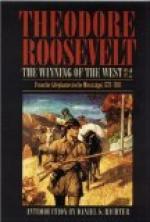Thus it enumerates the companies which fought the
battle in detail, the result running up several hundred
more than the total he gives. The early and official
accounts are in every way more worthy of credence;
but the point is settled beyond dispute by Hill’s
narrative. Hill was one of the four hundred men
with Williams, and he expressly states that after the
junction at the Cowpens the force, from both commands,
that started out numbered nine hundred and thirty-three.
The question is thus definitely settled. Most
of the later accounts simply follow the statements
Shelby made in his old age.] The British forces were
composed in bulk of the Carolina loyalists—troops
similar to the Americans who joined the mountaineers
at Quaker Meadows and the Cowpens [Footnote: There
were many instances of brothers and cousins in the
opposing ranks at King’s Mountain; a proof of
the similarity in the character of the forces.]; the
difference being that besides these low-land militia,
there were arrayed on one side the men from the Holston,
Watauga, and Nolichucky, and on the other the loyalist
regulars. Ferguson had, all told, between nine
hundred and a thousand troops, a hundred and twenty
or thirty of them being the regulars or “American
Volunteers,” the remainder tory militia. [Footnote:
The American official account says that they captured
the British provision returns, according to which their
force amounted to eleven hundred and twenty-five men.
It further reports, of the regulars nineteen killed,
thirty-five wounded and left on the ground as unable
to march, and seventy-eight captured; of the tories
two hundred and six killed, one hundred and twenty-eight
wounded and left on the ground unable to march, and
six hundred and forty-eight captured. The number
of tories killed must be greatly exaggerated.
Allaire, in his diary, says Ferguson had only eight
hundred men, but almost in the same sentence enumerates
nine hundred and six, giving of the regulars nineteen
killed, thirty-three wounded, and sixty-four captured
(one hundred and sixteen in all, instead of one hundred
and thirty-two, as in the American account), and of
the tories one hundred killed, ninety wounded, and
“about” six hundred captured. This
does not take account of those who escaped. From
Ramsey and De Peyster down most writers assert that
every single individual on the defeated side were killed
or taken; but in Colonel Chesney’s admirable
“Military Biography” there is given the
autobiography or memoir of a South Carolina loyalist
who was in the battle. His account of the battle
is meagre and unimportant, but he expressly states
that at the close he and a number of others escaped
through the American lines by putting sprigs of white
paper in their caps, as some of the whig militia did—for
the militia had no uniforms, and were dressed alike
on both sides. A certain number of men who escaped
must thus be added.] The forces were very nearly equal
in number. What difference there was, was probably




